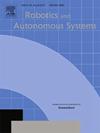Enhanced dynamic visual SLAM system for hospital logistics robots: Nonlinear optimal filtering, deep learning, and real-time positioning
IF 4.3
2区 计算机科学
Q1 AUTOMATION & CONTROL SYSTEMS
引用次数: 0
Abstract
Current Simultaneous Localization and Mapping (SLAM) systems frequently exhibit increased positioning errors, inaccuracies in map creation, and struggle with real-time multimodal sensor data fusion in dynamic environments. This paper introduces an improved SLAM system for hospital logistics robots that utilizes nonlinear optimal filtering and deep learning to navigate the challenges presented by dynamic environments. The system incorporates an Unscented Kalman Filter (UKF) for nonlinear state estimation and employs Convolutional Neural Networks (CNN) for deep feature extraction of environmental images. Semantic edge detection is accomplished through the integration of Fully Convolutional Networks (FCN) and Canny edge detection. The fusion of multimodal data is optimized using an Extended Kalman Filter (EKF) to enhance positioning accuracy across vision, lidar, and inertial measurement unit (IMU) sensors. Real-time motion estimation is achieved via an event-based camera paired with an optical flow algorithm. The proposed system delivers an absolute trajectory error (ATE) as low as 0.067 m, over 90 % overlap in map construction, and an average frame processing time under 90 ms, significantly surpassing the performance of other mainstream SLAM systems. These enhancements markedly improve positioning accuracy, mapping quality, and real-time performance in complex hospital environments.
用于医院物流机器人的增强动态视觉SLAM系统:非线性最优滤波、深度学习和实时定位
当前的同步定位和地图绘制(SLAM)系统经常表现出越来越多的定位误差,地图创建中的不准确性,以及在动态环境中与实时多模态传感器数据融合的斗争。本文介绍了一种改进的医院物流机器人SLAM系统,该系统利用非线性最优滤波和深度学习来应对动态环境带来的挑战。该系统采用Unscented卡尔曼滤波器(UKF)进行非线性状态估计,并采用卷积神经网络(CNN)对环境图像进行深度特征提取。语义边缘检测是将全卷积网络(FCN)和Canny边缘检测相结合来实现的。多模态数据融合使用扩展卡尔曼滤波器(EKF)进行优化,以提高视觉、激光雷达和惯性测量单元(IMU)传感器之间的定位精度。实时运动估计是通过一个基于事件的相机配合光流算法来实现的。该系统的绝对轨迹误差(ATE)低至0.067 m,地图构建重叠超过90%,平均帧处理时间低于90 ms,显著优于其他主流SLAM系统的性能。这些增强功能显著提高了复杂医院环境中的定位精度、制图质量和实时性能。
本文章由计算机程序翻译,如有差异,请以英文原文为准。
求助全文
约1分钟内获得全文
求助全文
来源期刊

Robotics and Autonomous Systems
工程技术-机器人学
CiteScore
9.00
自引率
7.00%
发文量
164
审稿时长
4.5 months
期刊介绍:
Robotics and Autonomous Systems will carry articles describing fundamental developments in the field of robotics, with special emphasis on autonomous systems. An important goal of this journal is to extend the state of the art in both symbolic and sensory based robot control and learning in the context of autonomous systems.
Robotics and Autonomous Systems will carry articles on the theoretical, computational and experimental aspects of autonomous systems, or modules of such systems.
 求助内容:
求助内容: 应助结果提醒方式:
应助结果提醒方式:


